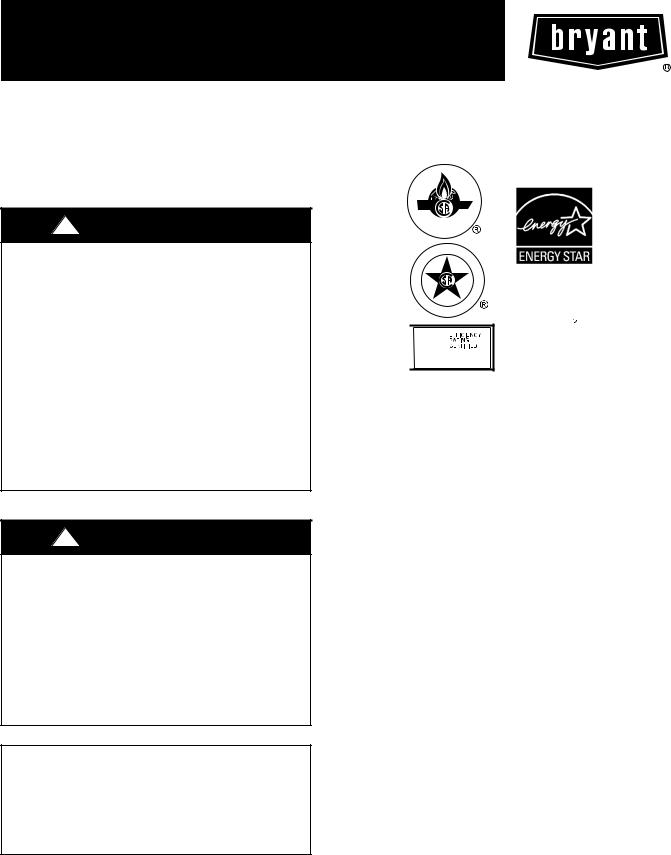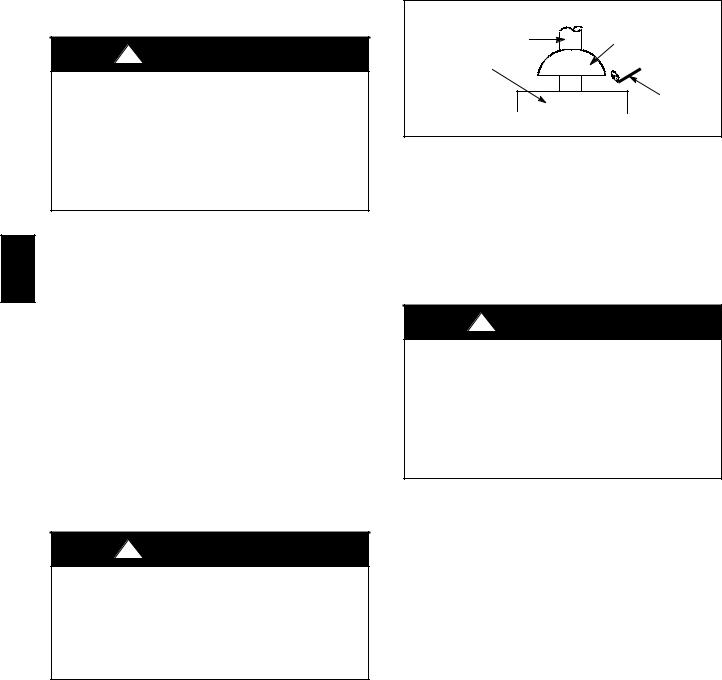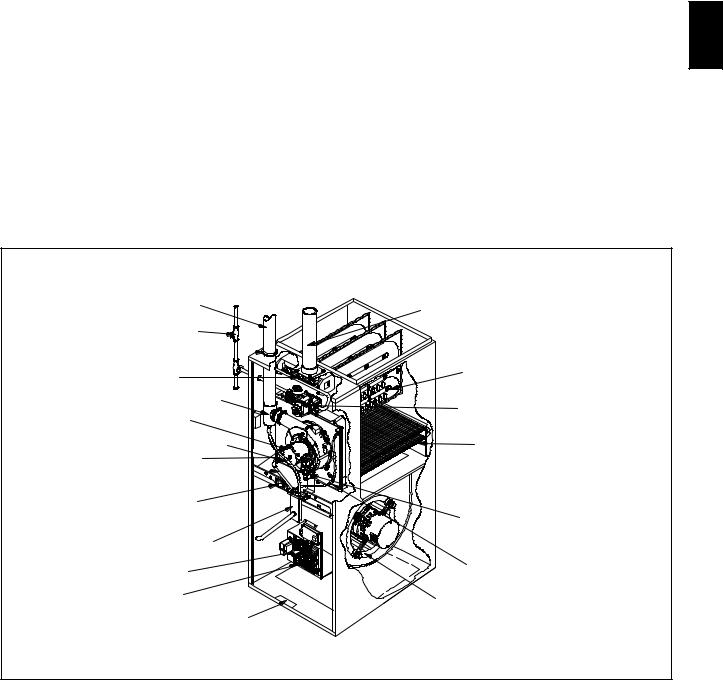Bryant 359AAV User Manual

359AAV
UPFLOW / HORIZONTAL / DOWNFLOW HIGH EFFICIENCY GAS FURNACE
Owner’s Manual
NOTE TO INSTALLER: THIS MANUAL MUST BE LEFT WITH THE EQUIPMENT USER.
USER: Please read all instructions in the manual and retain all manuals for future reference.
!WARNING
FIRE OR EXPLOSION HAZARD
Failure to follow safety warnings could result in injury, death, or property damage.
Do not store or use gasoline or other flammable vapors and liquids in the vicinity of this or any other appliance.
WHAT TO DO IF YOU SMELL GAS -Do not try to light any appliance.
-Do not touch any electrical switch; do not use any phone in your building.
-Leave the building immediately.
-Immediately call your gas supplier from a neighbor’s phone. Follow the gas supplier’s instructions.
-If you cannot reach your gas supplier, call the fire department.
Installation and service must be performed by a qualified installer, service agency or the gas supplier.
!WARNING
CARBON MONOXIDE POISONING HAZARD
Failure to follow this warning could result in personal injury and/or death.
Carbon Monoxide is invisible, odorless, and toxic! A carbon monoxide alarm is recommended in your home, even if you do not own a gas appliance. Locate the carbon monoxide alarm in the living area of your home and away from gas appliances and doorways to attached garages. Follow the alarm manufacturer’s instruction included with the alarm.
Do not use this furnace if any part has been under water. A flood-damaged furnace is extremely dangerous. Attempts to use the furnace can result in fire or explosion. A qualified service agency should be contacted to inspect the furnace and to replace all gas controls, control system parts, electrical parts that have been wet or the furnace if deemed necessary.
CERTIFIED
E S I G |
N |
D |
E |
|
D |
C |
E |
|
|
R T I FI |
|

 ama
ama
As an ENERGY STAR Partner, we have determined that this product meets the ENERGY STAR guidelines for energy efficiency.
Partner, we have determined that this product meets the ENERGY STAR guidelines for energy efficiency.
SAFETY CONSIDERATIONS
Recognize safety information. This is the safety-alert symbol  . When you see this symbol on the furnace and in instructions or manuals, be alert to the potential for personal injury.
. When you see this symbol on the furnace and in instructions or manuals, be alert to the potential for personal injury.
Understand the signal words: DANGER, WARNING, and CAUTION. DANGER identifies the most serious hazards which will result in severe personal injury or death. WARNING signifies hazards which could result in personal injury or death. CAUTION is used to identify unsafe practices which may result in minor personal injury or product and property damage. NOTE is used to highlight suggestions which will result in enhanced installation, reliability or operation.
To minimize the possibility of serious personal injury, fire, furnace damage, or improper operation; carefully follow these safety rules:
SYour gas furnace uses air from outside the home for combustion and vents flue gas to the outdoors. It is not to be installed using indoor air for combustion. The vent pipe must terminate outside
the structure and must not be obstructed in any way. The air-intake pipe must terminate outside the structure or in a well ventilated area that is isolated from the living space and the garage (e.g. well ventilated attic or crawlspace). Do not block or obstruct air openings on furnace or spaces around furnace.
SKeep the area around your furnace clear and free of combustible materials, gasoline, and other flammable liquids and vapors.
1

359AAV
Combustion Air (Your Safety)
!WARNING
CARBON MONOXIDE POISONING HAZARD
Failure to follow this warning could result in personal injury or death.
All fuel-burning appliances must be provided with enough fresh air for proper combustion and ventilation of flue gases.
Some models use air from the space in which they are located, and other appliances in thesamespace may also be using indoor air for ventilation and/or combustion.
New materials and methods are being used in construction and remodeling which result in lower energy costs for heating and cooling. It may also mean your appliances may not be getting enough air for combustion and ventilation of flue gases. The use of exhaust fans, fireplaces, clothes dryers, and other appliances consume air or vent it to the outdoors.
If the gas appliances or heating furnace can’t get enough air, two conditions may result:
1.The appliances or furnace may produce carbon monoxide gas.
2.The appliance may not vent flue gases properly. The following are signs that your appliances may not be getting enough air for proper combustion.
Be aware of these signals:
1.Headaches, Nausea, Dizziness
2.Excessive humidity--heavily frosted windows or a moist “clammy” feeling in the structure.
3.Smoke from the fireplace won’t draw up the chimney.
!WARNING
CARBON MONOXIDE POISONING HAZARD
Failure to follow this warning could result in personal injury or death.
If you experience headaches, nausea, or dizziness, carbon monoxide may be present. Leave the house immediately and call your gas supplier.
Combustion Air Checks
If any of the above signals are noticed, perform a combustion air check or call a qualified service agency. If you add weather stripping, storm windows, insulation, an additional fuel burning appliance, or remodel the structure, a combustion air check MUST be accomplished after the addition.
Make the inspection as follows:
1.Close all doors and windows. If you have a fireplace, start a fire and wait until flames are burning vigorously.
2.Turn on all exhausting devices, such as: kitchen and bathroom exhaust fans and dryers (gas or electric).
3.Turn on all vented gas appliances, such as: heating equipment (includes any room heaters) and water heaters.
4.Wait ten (10) minutes for drafts to stabilize.
5.On appliances with a draft hood, check for spillage by holding a lighted match 2” (50.8 mm)from the draft hood opening. Reference Fig. 1, which shows a water heater draft hood.
Vent Pipe |
Draft Hood |
Typical Gas
Water Heater
Match
A07688
Fig. 1 - Water Heater Draft Hood
a.Match flame pulls toward draft hood.
This indicates no spillage and that appliance is getting enough air for combustion. Return exhausting devices and appliances to the condition in which you found them.
b.Match goes out or flame wavers away from draft hood.
This indicates spillage and that appliance is not getting enough air for combustion.
!WARNING
CARBON MONOXIDE POISONING HAZARD
Failure to follow this warning could result in personal injury or death.
Draft hood spillage means there is not enough air for proper combustion and carbon monoxide may be present.
Keep a window open a minimum of 2” (50.8 mm) near the appliance until a permanent combustion air duct is installed. Contact a qualified service agency.
If draft hood spillage is indicated:
1.Check for plugged vent connectors and chimneys. Repair stoppage and test again.
2.If you have a fireplace, open a window or door near the fireplace and then check for spillage. If spillage stops, do not use the fireplace until you can supply fresh air by a permanent duct.
3.If you have kitchen and bathroom exhaust fans, turn them OFF and check for spillage. If spillage stops, do not use exhaust fans until you can supply fresh air by a permanent duct. Circuit breakers for fans should be turned off and marked as to why they are off.
4.Spillage means air starvation and that an outdoor air duct or air intake must be installed to provide air directly to the area around the furnace. This duct or intake MUST comply with local and state building codes or in their absence with the National Fuel Gas Code NFPA 54/ANSI Z223.1-2006 in the U.S., or the National Standard of Canada, Natural Gas and Propane Installation Code CSA B-149.1-2006 in Canada.
Indoor Humidity (Your Comfort)
Relative humidity is important to your health. Proper humidification helps cut down incidences of respiratory illness. Air that is too wet may damage the building structure. Air that is too dry is uncomfortable. A quick way to test for proper humidity is as follows:
1.Look for frequent fogging or excessive condensation on the inside of windows. This indicates the indoor humidity level is too high for outdoor weather conditions.
2.Drop three ice cubes into a glass of water and stir. If, within three minutes, moisture does not form on the glass, the air is too dry and a humidifier would be beneficial. (Do not per-
2

form this test in the kitchen, cooking vapors may produce inaccurate results.)
A good relative humidity is one just high enough to barely start condensation along the lower edges or lower corners of the windows, when it is cold outside. More than that can be damaging.
If the humidity is too high, try these suggestions to lower the humidity:
1.Reduce setting or discontinue use of humidifier.
2.Use range and bathroom exhaust fans while cooking and bathing. Open a door or window for a few minutes to bring in cool drier air.
3.Cook with pans covered.
4.Take shorter baths or showers with cooler water.
5.Install a fresh air intake duct. Cold, dry air brought in from outside to the furnace area lowers the indoor humidity level.
6.Have appliances checked. A malfunctioning appliance can contribute water vapor to the structure.
7.If the problem continues, consult a heating contractor about adding a heat recovery ventilator or air-to-air heat exchanger.
About Your Furnace
Fig. 2 shows the location of the components in the furnace.
Circulating Air Blower
The blower circulates room air through the furnace, air ducts, and into the rooms of the structure. The blower can be set at the thermostat for automatic or manual operation. In manual mode the blower operates continuously. In automatic, the blower does not come on until a preset time after the gas valve is energized. When the structure reaches the temperature set on the thermostat, the furnace will shut off. The blower will continue to run until the furnace cools down.
Thermostat
There are many types and styles of thermostats. Most thermostats control both heating and cooling functions and have a Fan Switch with AUTO and ON settings. On AUTO, the Circulating Air Blower will cycle on/off with the furnace on the heating speed unless a call for cooling is initiated. Blower speed will correspond to the mode of operation of the furnace. If the Fan Switch is positioned to ON the blower will run continuously.
In addition some thermostats are programmable with multiple set backs. The set backs can be pre-programmed to lower or raise the temperature automatically.
Be sure to become familiar with your thermostat.
Rating Plate
The rating plate contains important information for the service technician and lists the complete model, manufacturing and serial numbers. You should always provide all these numbers when requesting parts or if you need service. See Fig. 2 for rating plate location.
Door Interlock Switch
All the electrical power for the furnace goes through the door interlock switch. The interlock switch interrupts electrical power to the furnace when the blower door is removed. The furnace will not operate until the blower door is reinstalled.
Furnace Control
The furnace control provides power to the circulating air blower to keep it on until the furnace cools down.
The fan off-delay setting can be adjusted if the fan remains on long enough that cool drafts are felt in the room after the furnace shuts off.
359AAV
Furnace Vent Pipe (Vent Pipe Connec-
tions through Side Panel on Some Models- Air Intake Pipe
(Required only for Direct--Vent Furnaces)
Manual Gas Shutoff Valve
Vent Pipe Grommet 
Ignitor & Flame Sensor |
Primary Heat Exchanger |
|
(not shown) |
|
|
Vent Drain Fitting |
Furnace Main Gas Control Valve |
|
Combustion Blower |
||
|
||
1/2″ I.D. Vent Pipe Drain Hose |
Secondary Heat Exchanger |
|
5 /8″I.D. Transition Box Drain Hose |
|
|
Door Interlock Switch |
Pressure Switches |
|
|
||
|
(some models have one) |
|
Condensate Trap |
|
|
Diagnostic Light |
Plastic Transition Box |
|
|
||
Furnace Control |
Circulating Air Blower |
|
|
||
Rating Plate |
|
Representative drawing only, some models may vary in appearance.
A09280
Fig. 2 - Component Locations for Condensing 90+ Furnaces
3
